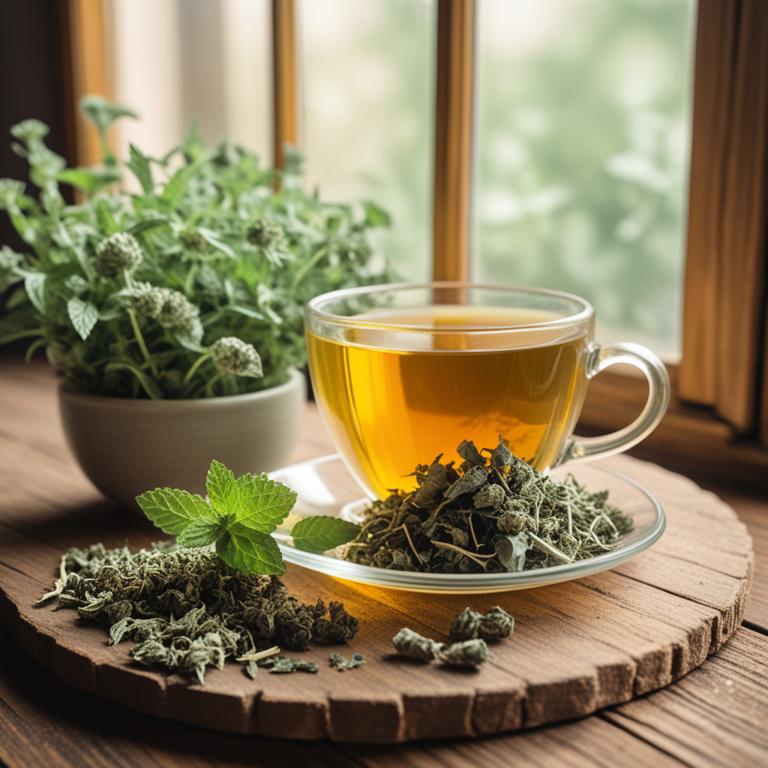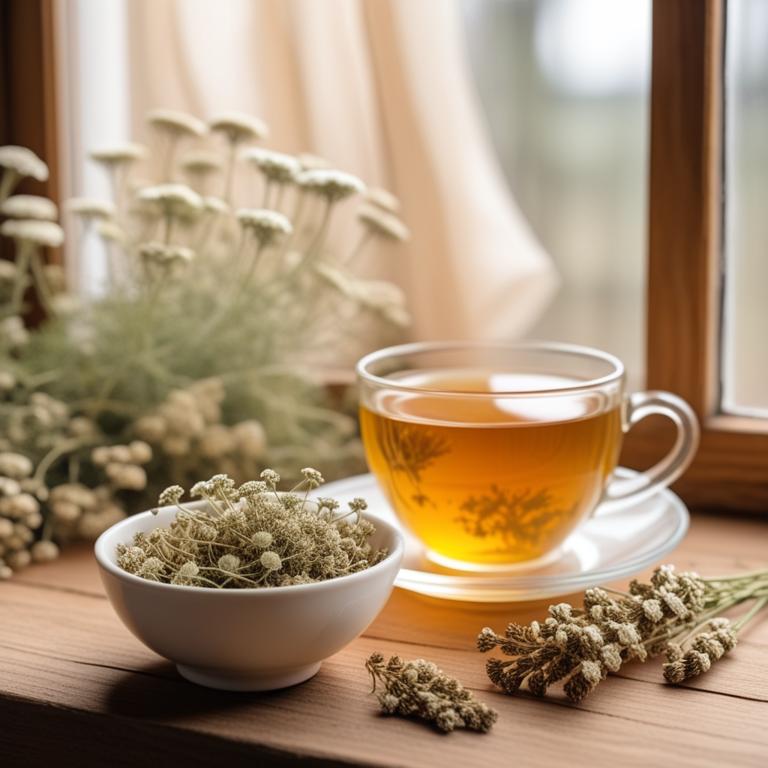9 Herbal Teas For Gum Pain

Herbal teas have been used for centuries to alleviate gum pain, and for good reason.
These teas work by targeting the root causes of discomfort, such as inflammation and infection. For example, Melissa officinalis, also known as lemon balm, has natural anti-inflammatory properties that help reduce swelling and ease pain. Its soothing effects can calm irritated gums and promote a sense of relaxation.
Echinacea purpurea, a popular herb in herbal remedies, contains compounds that boost the immune system, helping to fight off underlying infections that may be causing gum pain. Glycyrrhiza glabra, or licorice root, has anti-inflammatory and antibacterial properties that can help reduce inflammation and prevent infection. Drinking these herbal teas can bring several benefits to your life. Not only can they help alleviate gum pain, but they can also reduce stress and anxiety, promote better sleep, and even support overall oral health.
By incorporating herbal teas into your daily routine, you can take a natural and effective approach to managing gum pain and maintaining a healthy, happy smile.
- 1. Melissa officinalis
- 2. Echinacea purpurea
- 3. Glycyrrhiza glabra
- 4. Eucalyptus globulus
- 5. Salvia officinalis
- 6. Zingiber officinale
- 7. Mentha x piperita
- 8. Achillea millefolium
- 9. Camellia sinensis
1. Melissa officinalis

Melissa officinalis teas contains boiactive constituents like linalool, linalyl acetate, and geraniol.
These compounds have anti-inflammatory properties that can help reduce swelling and ease pain in the gums. The tea's antioxidant properties also help protect the gums from damage caused by free radicals, which can contribute to gum pain. Additionally, Melissa officinalis teas has antimicrobial properties that can help prevent infections that may be causing the gum pain.
By reducing inflammation and preventing infections, Melissa officinalis teas can help alleviate gum pain and promote overall gum health.
- Gather 1 cup of fresh Melissa officinalis leaves or 1 teaspoon of dried leaves.
- Boil 1 cup of water in a pot.
- Remove the pot from heat and add the Melissa officinalis leaves.
- Steep for 5-7 minutes, then strain the leaves from the water.
- Drink the tea warm or at room temperature, 3-4 times a day for gum pain relief.
2. Echinacea purpurea

Echinacea purpurea teas contains compounds like alkylamides, caffeic acid derivatives, and volatile oils.
These constituents have anti-inflammatory properties, which help to reduce swelling and pain in the gums. The alkylamides in Echinacea purpurea teas also have antioxidant properties, which can help to protect the gums from damage caused by free radicals. Caffeic acid derivatives in the tea have antimicrobial properties, which can help to fight off bacteria that can cause gum infections and pain.
By reducing inflammation, fighting off bacteria, and protecting the gums from damage, Echinacea purpurea teas may provide relief from gum pain.
- Gather 2 teaspoons of dried Echinacea purpurea flowers and 1 cup of boiling water.
- Place the Echinacea flowers in a tea infuser or a small muslin bag.
- Pour the boiling water over the Echinacea flowers and let it steep for 5-7 minutes.
- Strain the tea into a cup and discard the Echinacea flowers.
- Drink 1/2 cup of the Echinacea tea 3-4 times a day to help ease gum pain.
3. Glycyrrhiza glabra

Glycyrrhiza glabra teas contains glycyrrhizin, a triterpenoid saponin, and flavonoids like liquiritin and isoliquiritin.
These bioactive constituents have anti-inflammatory properties, which help reduce swelling and pain in the gums. Glycyrrhizin also has a licorice-like flavor and acts as a natural antiseptic, helping to heal gum infections and soothe irritated tissues. The flavonoids in Glycyrrhiza glabra teas have antioxidant properties, which protect the gums from free radicals and promote healthy cell growth.
By reducing inflammation and promoting healing, Glycyrrhiza glabra teas can help alleviate gum pain and discomfort.
- Gather 1 cup of fresh or dried Glycyrrhiza glabra roots.
- Rinse the roots in cold water and chop them into small pieces.
- Place 1-2 tablespoons of the chopped roots in a tea infuser or a heat-resistant cup.
- Boil 1 cup of water and pour it over the roots in the infuser or cup.
- Steep for 5-7 minutes, then strain and drink as needed to alleviate gum pain.
4. Eucalyptus globulus

Eucalyptus globulus teas contains flavonoids, tannins, and phenolic acids, which are key bioactive constituents that contribute to its effectiveness in relieving gum pain.
Flavonoids, specifically quercetin and kaempferol, have anti-inflammatory properties that help reduce swelling and pain in the gums. Tannins, on the other hand, exhibit antimicrobial properties, which can help prevent bacterial growth and infection in the gums. The phenolic acids present in Eucalyptus globulus teas, such as caffeic acid and ferulic acid, have antioxidant properties that can help reduce inflammation and promote healing in the gums.
By reducing inflammation, antimicrobial activity, and promoting healing, Eucalyptus globulus teas can help alleviate gum pain and discomfort.
- Gather 1 cup of fresh eucalyptus leaves (Eucalyptus globulus) or 1 teaspoon of dried eucalyptus leaves.
- Combine the eucalyptus leaves with 1 cup of boiling water in a heat-resistant cup or teapot.
- Let the mixture steep for 5-10 minutes, depending on your desired tea strength.
- Strain the tea into another cup using a tea strainer or cheesecloth to remove the leaves.
- Drink the tea hot or cold, as you prefer, to help soothe gum pain and inflammation.
5. Salvia officinalis

Salvia officinalis teas contains bioactive constituents like rosmarinic acid and carnosic acid.
These compounds have anti-inflammatory properties that help reduce swelling and pain in the gums. The antioxidants in Salvia officinalis teas also have antimicrobial properties, which can prevent bacterial infections that cause gum pain. Additionally, the flavonoids in Salvia officinalis teas, such as apigenin and luteolin, have anti-inflammatory and antioxidant effects that can help soothe gum pain.
By reducing inflammation and preventing infections, Salvia officinalis teas can provide relief from gum pain.
- Get 1 cup of boiling water.
- Add 2 tablespoons of dried Salvia officinalis leaves to a cup.
- Pour the boiling water over the leaves.
- Let it steep for 5-7 minutes, then strain.
- Drink 1/2 cup of the tea, 2-3 times a day for gum pain relief.
6. Zingiber officinale

Zingiber officinale teas contains compounds like gingerol and shogaol, which are responsible for its anti-inflammatory properties.
These compounds help reduce swelling and pain in the gums by blocking the production of prostaglandins, hormone-like substances that cause pain and inflammation. Gingerol and shogaol also have antioxidant properties, which help protect the gums from damage caused by free radicals. Additionally, the analgesic properties of Zingiber officinale teas help numb the pain in the gums, providing relief from discomfort.
The anti-inflammatory and analgesic properties of gingerol and shogaol make Zingiber officinale teas a potential remedy for gum pain.
- Gather 1 cup of fresh ginger root and chop it into small pieces.
- Boil 1 cup of water in a pot.
- Add 2-3 tablespoons of chopped ginger to the boiling water.
- Reduce heat and let the mixture simmer for 5-7 minutes.
- Strain the tea and drink it while warm to relieve gum pain.
Zingiber Officinale Tea on Amazon
FGO Organic Ginger Tea, 100 Count, Eco-Conscious Tea Bags, Caffeine Free, Packaging May Vary (Pack of 1)
Disclaimer: We earn a commission if you click this link and make a purchase at no additional cost to you.
7. Mentha x piperita

Mentha x piperita teas contains several bioactive constituents, including menthol, menthone, and limonene.
These compounds have anti-inflammatory and analgesic properties, which help to reduce pain and swelling in the gums. The menthol in mentha x piperita teas also has a numbing effect, which can temporarily relieve gum pain by blocking the nerve signals that transmit pain to the brain. Additionally, the antioxidants in mentha x piperita tea help to reduce inflammation and protect the gums from damage.
By consuming mentha x piperita tea, people can benefit from its pain-relieving and anti-inflammatory properties to alleviate gum pain.
- Gather 1 cup of fresh mint leaves (Mentha x piperita) and 1 cup of boiling water.
- Steep the mint leaves in the boiling water for 5-7 minutes. Strain the mixture with a fine-mesh sieve into a cup.
- Add 1 tablespoon of honey to the tea for taste, if desired.
- Let the tea cool down to a comfortable temperature for consumption.
- Drink 1/2 cup of the tea 2-3 times a day to help soothe gum pain.
8. Achillea millefolium

Achillea millefolium teas contains sesquiterpene lactones, mainly 11-beta-hydroxy-11,13-dihydroachillenolide, which are responsible for its anti-inflammatory properties.
These sesquiterpene lactones reduce inflammation and swelling in the gums, providing relief from pain and discomfort. The tea also contains flavonoids, including kaempferol and quercetin, which have antioxidant properties that help combat free radicals and promote healing. The anti-inflammatory and antioxidant properties of Achillea millefolium teas help reduce gum pain by soothing and protecting the gums from further irritation and damage.
Regular consumption of this tea may help maintain healthy gums and reduce the risk of gum disease.
- Gather 1 cup of fresh or dried Achillea millefolium leaves and flowers.
- Measure 1 tablespoon of the gathered leaves and flowers and place them in a tea infuser or a heat-resistant cup.
- Boil 1 cup of water and pour it over the leaves and flowers in the tea infuser or cup.
- Steep the mixture for 5-7 minutes and then strain it to remove the leaves and flowers.
- Drink the tea 2-3 times a day to help alleviate gum pain and inflammation.
9. Camellia sinensis

Camellia sinensis teas contains a wealth of bioactive compounds, including theaflavins and thearubigins, which are powerful antioxidants.
These compounds help reduce inflammation and ease gum pain by inhibiting the production of pro-inflammatory enzymes. The tea also contains flavonoids, specifically epicatechin and quercetin, which have anti-inflammatory properties that can soothe irritated gum tissue. Additionally, the tea's high antioxidant content helps protect the gums from oxidative stress, which can contribute to pain and discomfort.
The combination of these compounds in Camellia sinensis teas makes it a potential natural remedy for gum pain.
- Gather 1 teaspoon of Camellia sinensis leaves, 1 cup of water, and a tea infuser.
- Heat water to 98°C (208°F) and pour it over the leaves in the infuser.
- Steep the leaves for 3-5 minutes, then remove the infuser.
- Strain the tea into a cup and discard the leaves. Add honey or sugar if desired.
- Drink the tea 2-3 times a day for relief from gum pain.